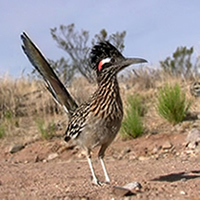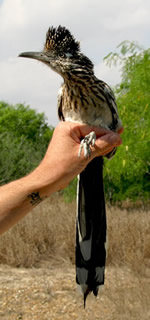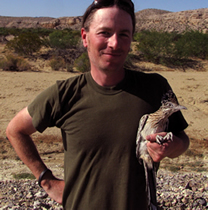Conservation Genetics Research of the Greater Roadrunner - A CodonCode Aligner User Showcase


How CodonCode Aligner can be used for population and conservation genetics can be seen in the case of researcher Michael MacDonald. He uses CodonCode Aligner to study the genetic variation and the gene flow in the Greater Roadrunner (Geococcyx californianus).
His research at the San José State University in California focuses on providing a comprehensive study of roadrunner population genetics. This study will serve as a foundation for future population genetic and conservation genetic research.
Michael uses CodonCode Aligner's features like base calling and different ways of generating sequence assemblies and alignments to analyze the data from multiple sampling trips.
Studying the Greater Roadrunner
by Michael MacDonald
Habitat alteration and destruction are among the greatest threats to the survival of species. Among other consequences, habitat alteration can result in the reduction or loss of connectivity among populations which in turn alters patterns of gene flow.
Preserving adaptive diversity and evolutionary processes of species is one of the main goals of conservation. The maintenance of historic connectivity and gene flow between populations is therefore crucial. Consequently, understanding both the population structure of a species and the gene flow between its populations is essential for conservation planning.

The Greater Roadrunner (Geococcyx californianus) is a large New-World ground cuckoo and is a familiar resident of the deserts and scrublands of the American Southwest and Mexico. In recent history, much of the habitat in which roadrunners occur has been significantly altered and fragmented. Known for their large territory requirements, roadrunners are particularly sensitive to the effects of urbanization and habitat fragmentation and have been extirpated from numerous fragmented habitats as well as from several regions in California.
Our current understanding of these patterns in greater roadrunners is deficient as there have been no population genetic studies of roadrunners to date. An examination of population structure, gene flow, and genetic variation is therefore a priority in roadrunner research and conservation.
Numerous greater roadrunner populations in fragmented and degraded habitats merit closer genetic investigation, particularly in areas such as fragmented Southern California coastal scrub-sage habitats. Because of their large territory requirements, any habitat protection implemented on behalf of roadrunners would also serve as an umbrella of protection for numerous other species that share these habitats, many of which are species of current conservation concern. Prior to any such study, however, patterns of genetic variation and gene flow in roadrunner populations at large must first be established in order to serve as a basis for comparison. My research will serve as this foundation.

To accomplish this, I am live-trapping, banding, and sampling roadrunners at numerous locations across their range. Most of my time in the lab has so far been spent focusing on mitochondrial markers though I am currently working on developing novel primers for nuclear markers in order to get a more complete picture of genetic variation in roadrunners.
Although roadrunners are well-known they remain poorly-studied. I hope that through my current and future research I can fill some of the gaps in knowledge and stimulate interest in this iconic bird.
How CodonCode Aligner Can Help with Research in Population Genetics

research subjects
CodonCode Aligner has multiple features that can be useful for Michael's type of research. After importing his data in CodonCode Aligner, he can assign quality scores to his samples by base calling with Phred, and trim the sequences using end clipping and vector trimming if necessary. All of these steps can be done automatically as part of "preprocessing" before sequence assembly or alignment.
To quickly assemble contigs for hundreds of different samples, Michael can use CodonCode Aligner's assemble by name feature. He can then edit sequences and contigs, although the use of highly accurate, quality-based consensus sequences minimizes the need for manual editing.
The next step is typically a multiple sequence alignment, where the consensus sequences of the different roadrunners are compared to each other. In CodonCode Aligner, the contigs can be aligned directly with Muscle, Clustal, or CodonCode's alignment methods. CodonCode Aligner keeps the reference to the underlying traces, and allows editing of the original sequence traces in the context of multiple sequence alignments.
To spot any differences between aligned contigs, Michael can use CodonCode Aligner's difference tables. A simple double click on one of the aligned contig sequences will show him the traces for this contig. Finally, all results can be printed or exported in different formats for further use - for example in publications.
